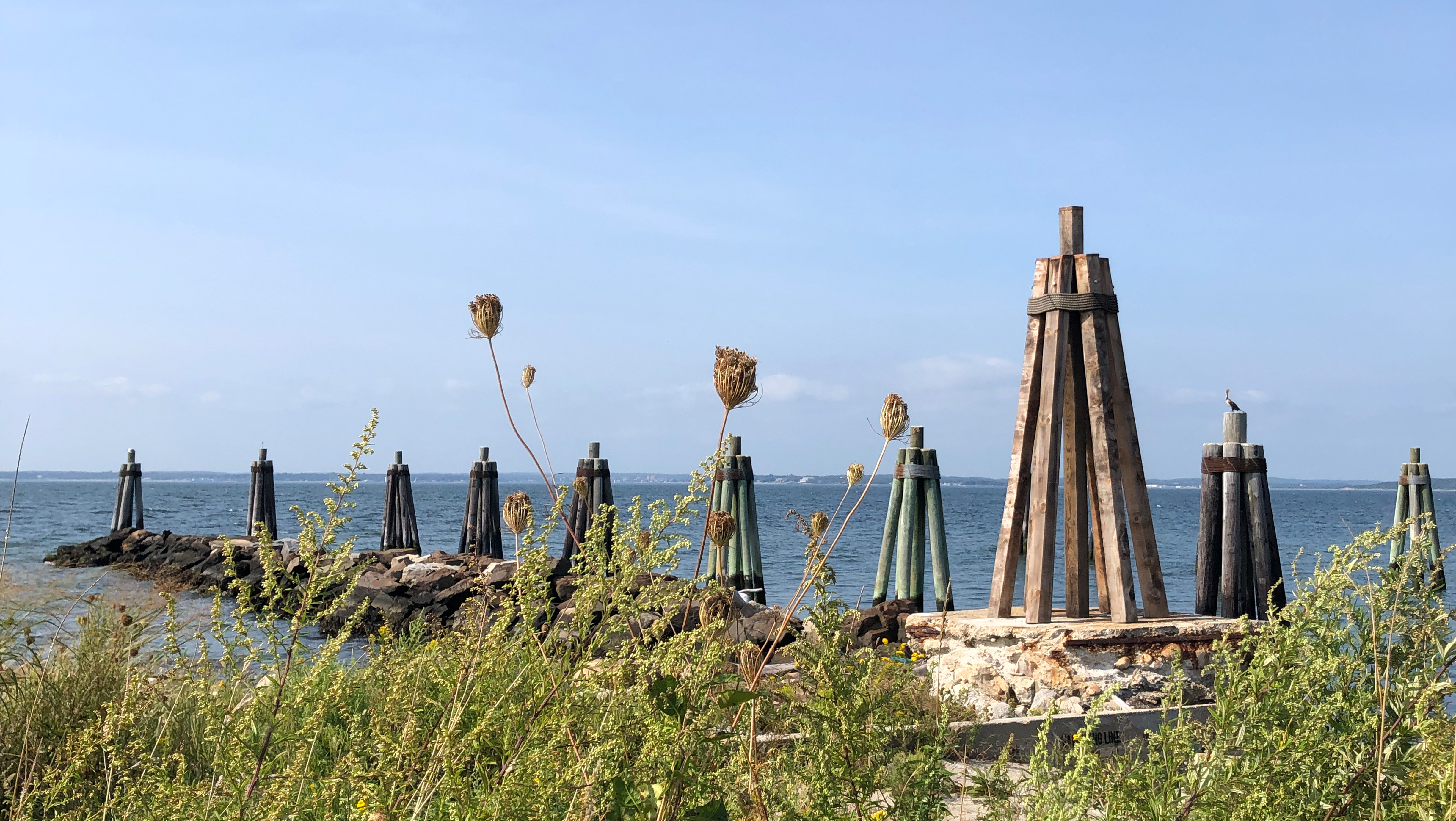May 1–Dec 31, 2019
Kambui Olujimi [6]
Vanishing Lines
Spruce, Oak, Copper, Rope, Hardware

About
Vanishing Lines by Kambui Olujimi asks us to consider that which we render invisible.
Disappearing against the backdrop of the 23 dolphins, tent-like utilitarian structures that define the entrance to Silver Eel Cove, the sculpture blurs the parameters of a known island space and challenges our understanding of that space within the context of its function and narrative.
Whether the sculpture extends as a metaphor for the history of the island, a pillar raised to a forgotten peoples and their history, or whether the work functions to question the invisible borders that delineate the places we call home, Vanishing Lines not only asks us to consider what we see before us but more importantly, what we don’t and why?
The sculpture’s physicality is a take on the form of a “dolphin“ which are common in ports and surround the sculpture’s plinth. Olujimi employs an 18-century Japanese building technique called Yakisugi in which he scorches and sands the surfaces of the pylons accentuating the charred woodgrain pattern. The use of flames in the work also references the opportunity that wildfire presents. Each pylon was cut into hexagonal pillars that interlock. At a distance, the work camouflages with its surrounding aging dolphins but upon closer inspection, it reveals a new voice and the deviation of the artist’s intervention.
Artist
Bio
Kambui Olujimi was born and raised in Bedford Stuyvesant, Brooklyn. He received his MFA from Columbia University School of the Arts and is a graduate of Parson’s School of Design and the Skowhegan School of Painting and Sculpture. Olujimi works within the realm of ideas rather than within an exclusive medium. Although he has directed a great deal of work in film, his is truly a multi-media practice. He crafts potent social commentary from delicate wisps of myth and whimsy mixed with real-world narrative. Lyrical and elliptical rather than ideological, Olujimi’s art transcends the political sphere, affirming its own autonomy.
Olujimi’s work has been exhibited widely across the United States, with solo exhibitions at the CUE Arts Foundation (New York, NY); MIT List Visual Arts Center (Cambridge, MA); Apexart (New York, NY); and Art in General (Brooklyn, NY). His work has premiered at The Sundance Film Festival (Park City, UT), as well as group exhibitions at the Smithsonian Institute, (Washington D.C.); Museum of Contemporary Art Los Angeles (Los Angeles, CA); the Museum of Modern Art (New York, NY); Studio Museum in Harlem (New York, NY); and Yerba Buena Center for the Arts (San Francisco, CA). Internationally he has exhibited at Museo Nacional Reina (Sofia, Madrid); Kiasma (Helsingfors, Finland); Para Site (Hong Kong, China); and The Jim Thompson Art Center (Bangkok, Thailand). His work is in the collections of the Brooklyn Museum of Art and the Orange County Museum of Art. His exhibitions have garnered reviews by Art in America, The New York Times, The New Yorker, ArtSlant, Modern Painters, Artforum, and The Brooklyn Rail, among others. In 2012, the exhibition monograph “Wayward North” was published by Art in General.
He has received numerous grants and fellowships including from A Blade of Grass, The Jerome Foundation, and The Fine Arts Work Center in Provincetown. Olujimi has completed residencies with Skowhegan School of Painting and Sculpture (Skowhegan, ME); Apexart (New York, NY), The Lower Manhattan Cultural Council (New York, NY) Civitella Ranieri (Umbertide, Italy), and The Fountainhead Residency (Miami, FL). He was most recently awarded a Rauschenberg Residency (Captiva, Florida). Kambui Olujimi has exhibited with Catharine Clark Gallery since 2010.